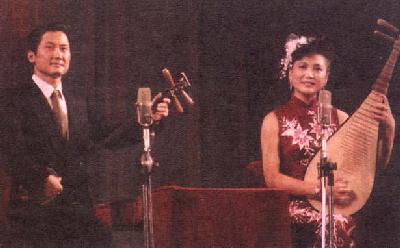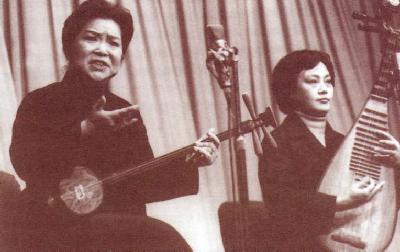SuzhouPingtanis a general term denoting SuzhouPinghuaandTanci,namely, storytelling and ballad singing in the Suzhou dialect. Flourishing in Suzhou, it also enjoys great popularity in Jiangsu and Zhejiang provinces as well as in Shanghai, the biggest metropolis in East China.
 |
| Xing Yanzhi and Xing Yanchun performing Suzhou Pingtan |
The art has a long history.
Pinghuadeveloped from the storytelling art of the Tang (618-907) and Song (960-1279) dynasties, and performers only spoke but not sang during the performance.
Pingtanevolved from
Bianwenthat propagandized Buddhist teachings in the Tang Dynasty. In the late years of the Ming Dynasty (1368-1644) and the early years of the Qing Dynasty (1644-1911), actors and actresses began to perform in Suzhou dialect, hence emerged Suzhou
Pingtan. Suzhou
Pingtanreached its peak in the reign of Emperor Qianlong (1739-1796) in the Qing Dynasty. In the subsequent more than 200 years, the art form saw much improvement. It is still popular today.
SuzhouPingtanis performed solo, in duet or as a trio, involving singing and storytelling. The small three-stringed plucked instrument andPipa(lute) are used as accompaniment. TheBan, or wooden clappers, produces various styles of tone and melody.Pingtanhas absorbed popular folk tunes. For instance,Shutone, came from otherQuyiforms and is the basis of other styles. Due to different performance styles,Shutone is divided into the Chen Yuquan, Ma Rufei and Yu Xiushan Schools. In the development of about a century, new styles were formed which inherited the legacy of the three schools. Liu Tianyun and Yang Zhenxiong inherited the Chen School: and Xia Hesheng and Zhu Huizhen inherited the Yu School. Ma School exerted the greatest impact on posterity, with Successors who formed schools of their own, such asXue Xiaoqing Diao(tone), Shen JiananDiaoand QinDiao(developed by Zhu Xueqin on the basis ofXue Diao). Zhou Yuquan developed into a school on the basis ofMa Diao, while Jiang Yuequan developed into a school on the basis ofZhou Diao.Due to this development, SuzhouPingtanhas a great diversity of styles in singing and storytelling.
 |
| Zhu Xueqin (left) in a performance of Suzhou Pingtan |
After the founding of the People's Republic of China, the government set up the research office of Suzhou
Pingtan, Suzhou Pingtan School and other institutes to protect and carry forward this traditional
Quyiart. After the 1980s, performers of Suzhou
Pingtanstaged performances and carried out exchanges in Japan, Singapore, Italy, the US and Canada, etc, where they introduced it to overseas communities with great success.
